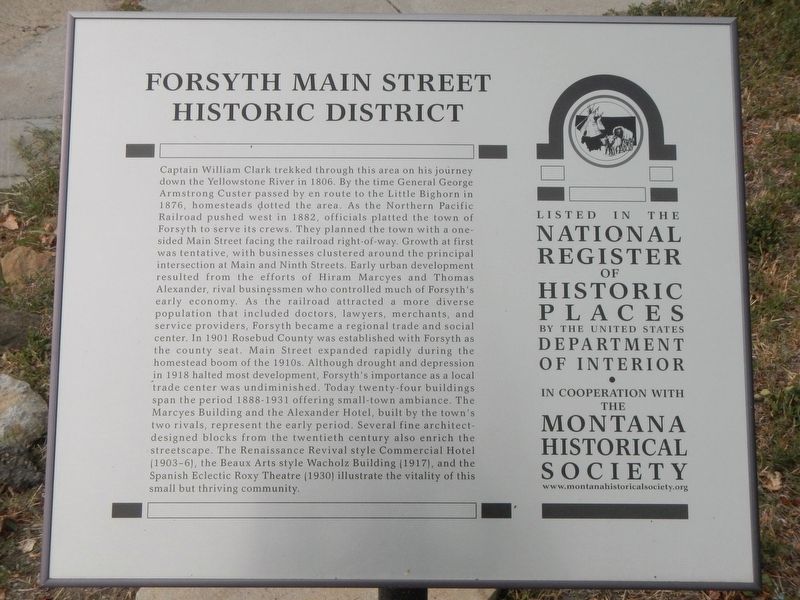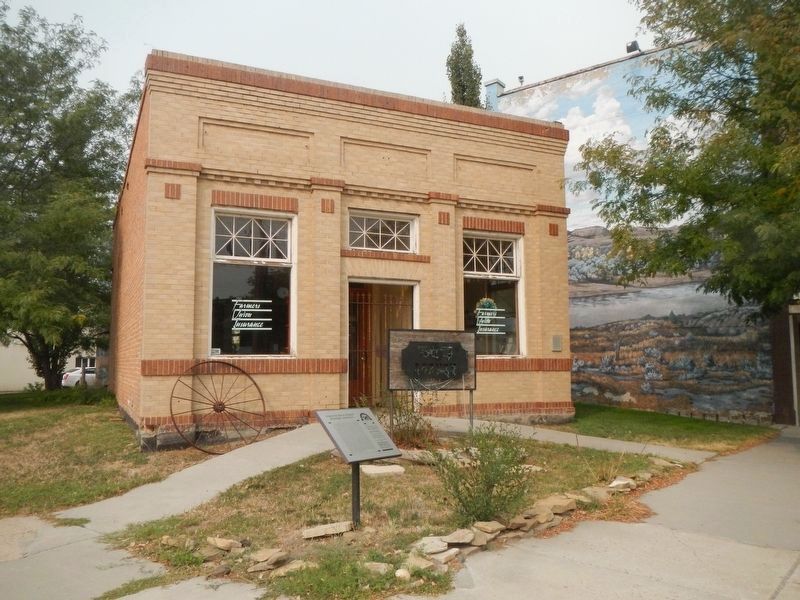Forsyth in Rosebud County, Montana — The American West (Mountains)
Forsyth Main Street Historic District
Inscription.
Captain William Clark trekked through this area on his journey down the Yellowstone River in 1806. By the time General George Armstrong Custer passed by en route to the Little Bighorn in 1876, homesteads dotted the area. As the Northern Pacific Railroad pushed west in 1882, officials platted the town of Forsyth to serve its crews. They planned the town with a one-sided Main Street facing the railroad right-of-way. Growth at first was tentative with businesses clustered around the principal intersection at Main and Ninth Streets. Early urban development resulted from the efforts of Hiram Marcyes and Thomas Alexander, rival businessmen who controlled much of Forsyth’s early economy. As the railroad attracted a more diverse population that included doctors, lawyers, merchants, and service providers, Forsyth became a regional trade and social center. In 1901 Rosebud County was established with Forsyth as the county seat. Main Street expanded rapidly during the homestead boom of the 1910s. Although drought and depression in 1918 halted most development, Forsyth’s importance as a local trade center was undiminished. Today twenty-four buildings span the period 1888-1931, offering small-town ambiance. The Marcyes Building and the Alexander Hotel, built by the town’s two rivals, represent the early period. Several fine architect-designed blocks
from the twentieth century also enrich the streetscape. The Renaissance Revival style Commercial Hotel (1903–6), the Beaux Arts style Wacholz Building (1917), and the Spanish Eclectic Roxy Theatre (1930) illustrate the vitality of this small but thriving community.
Erected by Montana Historical Society.
Topics and series. This historical marker is listed in these topic lists: Architecture • Industry & Commerce • Notable Buildings. In addition, it is included in the Montana National Register Sign Program series list. A significant historical year for this entry is 1806.
Location. 46° 15.971′ N, 106° 40.673′ W. Marker is in Forsyth, Montana, in Rosebud County. Marker is at the intersection of Main Street and North 10th Avenue, on the right when traveling west on Main Street. Touch for map. Marker is at or near this postal address: 1001 Main Street, Forsyth MT 59327, United States of America. Touch for directions.
Other nearby markers. At least 8 other markers are within walking distance of this marker. Vananda State Bank Building (here, next to this marker); Roxy Theatre (within shouting distance of this marker); Merchant Bank (within shouting distance of this marker); Masonic Temple (within shouting distance of this marker); 933 Main Street (about 300 feet away, measured in a direct line); Forsyth, MT
(about 400 feet away); Northway Residence (about 400 feet away); Choisser Block (about 400 feet away). Touch for a list and map of all markers in Forsyth.
Credits. This page was last revised on January 25, 2021. It was originally submitted on January 14, 2021, by Barry Swackhamer of Brentwood, California. This page has been viewed 152 times since then and 16 times this year. Photos: 1, 2. submitted on January 14, 2021, by Barry Swackhamer of Brentwood, California.

